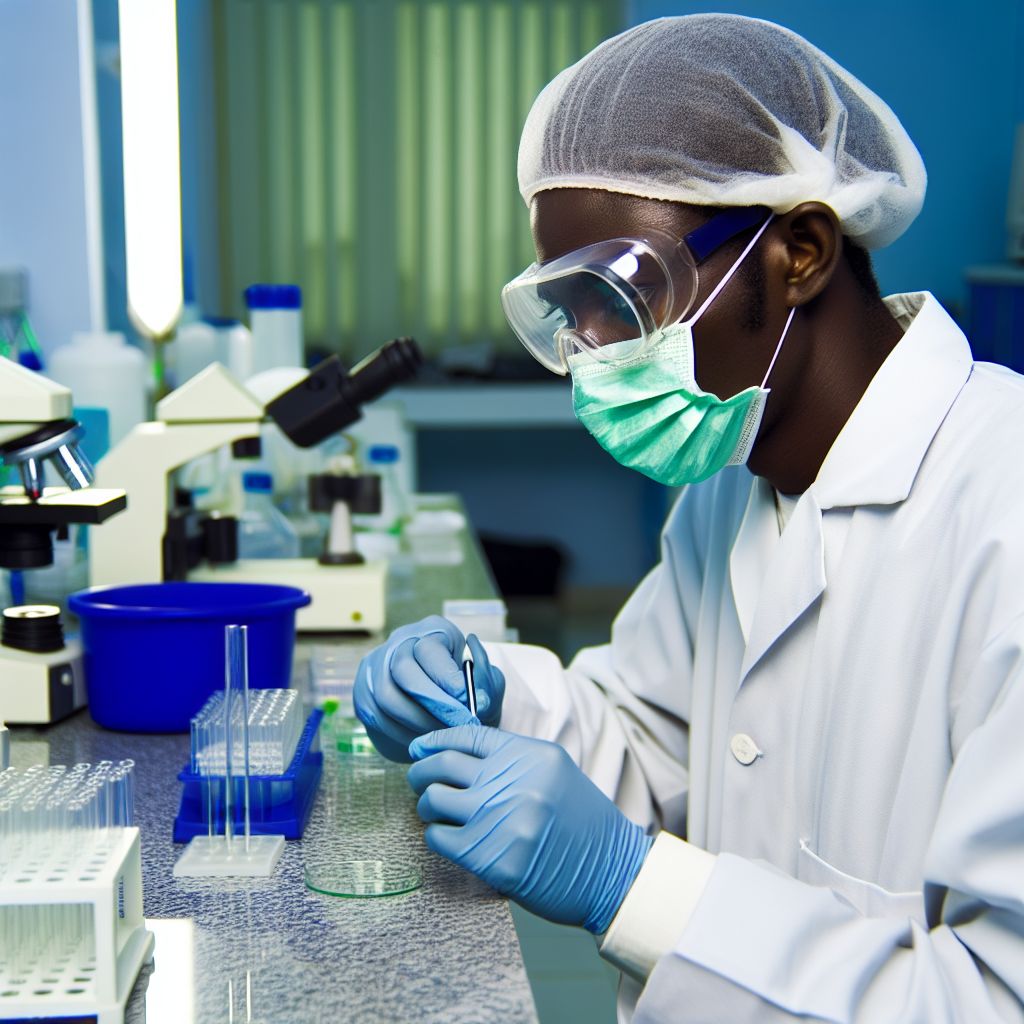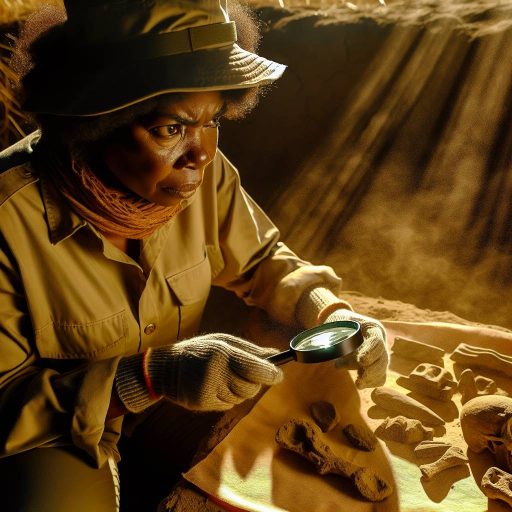Introduction:
Microbiology lab safety protocols are crucial in Nigeria to avoid accidents and contamination.
Working in a microbiology lab comes with potential risks like exposure to hazardous chemicals.
Following strict safety guidelines is essential to protect lab workers and maintain a safe environment.
Importance of Personal Protective Equipment (PPE) in Microbiology Labs:
- Discuss the essential PPE items such as lab coats, gloves, safety goggles, and masks.
- Explain how wearing proper PPE can protect lab workers from spills, splashes, and exposure to harmful pathogens.
- Emphasize the importance of regular maintenance and proper disposal of PPE.
In a microbiology lab, Personal Protective Equipment (PPE) plays a crucial role in ensuring the safety and well-being of lab workers.
First and foremost, lab coats are essential PPE items that provide a barrier between the lab worker’s skin and any potentially harmful pathogens present in the lab environment.
Gloves are another critical PPE item that helps prevent direct contact with hazardous materials, preventing contamination and reducing the risk of infection.
Safety goggles are necessary to protect the eyes from splashes, aerosols, and other potential hazards that could cause eye irritation or injury.
Additionally, wearing masks can help prevent the inhalation of harmful aerosols or droplets that may contain infectious agents, reducing the risk of respiratory infections.
Properly wearing and using PPE can significantly reduce the risk of exposure to hazardous materials and pathogens in the lab, protecting the health and safety of lab workers.
Regular maintenance of PPE is essential to ensure its effectiveness. Lab coats should be cleaned and sanitized regularly to prevent cross-contamination and the spread of pathogens.
Gloves should be replaced frequently, especially after handling potentially infectious materials, to prevent the spread of contamination.
Safety goggles should be inspected for any cracks or damage and replaced if necessary to maintain proper eye protection.
Masks should be disposed of properly after each use to prevent potential contamination and the spread of infectious agents.
Proper disposal of PPE is equally important. Used PPE items should be disposed of in designated waste bins or containers to prevent accidental exposure to others.
Following proper disposal protocols helps prevent the spread of contamination and ensures the safety of lab workers and other individuals in the lab environment.
Personal Protective Equipment (PPE) is vital in maintaining a safe and healthy working environment in microbiology labs.
By wearing the proper PPE, lab workers can protect themselves from spills, splashes, and exposure to harmful pathogens.
Regular maintenance and proper disposal of PPE are also essential to ensure its effectiveness and prevent the spread of contamination.
Remember, safety should always be the top priority in any lab setting.
Sterilization and Decontamination Procedures in the Lab:
Various methods of sterilization such as autoclaving, UV light, and chemical disinfectants.
Properly sterilize lab equipment, work surfaces, and materials to prevent contamination.
Importance of regular decontamination and cleaning schedules in microbiology labs.
Methods of Sterilization:
Autoclaving is the most common method of sterilization in microbiology labs.
It uses high-pressure steam to kill bacteria, fungi, and viruses on equipment and materials.
UV light is another effective method for sterilizing surfaces.
It damages the DNA and RNA of microorganisms, preventing them from reproducing.
Chemical disinfectants like bleach or ethanol can also be used to clean and sterilize equipment and work surfaces.
They are fast-acting and reliable.
Proper Sterilization Procedures:
Before starting any experiment, ensure that all equipment is properly sterilized.
Clean work surfaces with disinfectants to eliminate any potential contaminants.
Use autoclaves according to manufacturer’s instructions to sterilize glassware, pipettes, and other equipment.
Allow them to cool before use.
Always wear gloves and lab coats when handling potentially contaminated materials.
This helps prevent the spread of microorganisms.
Importance of Regular Decontamination:
Regular decontamination and cleaning schedules are essential to maintaining a safe working environment in microbiology labs.
Contaminated surfaces can lead to false results and compromised experiments.
Decontamination helps prevent the spread of pathogens and reduces the risk of infections among lab personnel.
It also ensures the accuracy and reliability of experimental data.
By following strict decontamination protocols, microbiology labs can create a sterile and controlled environment necessary for accurate research and analysis.
Find Out More: Impact of Animal Biology on Nigerian Ecosystems
Transform Your Career with Expert Guidance
Get personalized mentorship consulting that’s tailored to your unique path. Our expert advice is actionable and exclusive.
Get StartedSafe handling and disposal of biohazardous waste:
Properly handling and disposing of biohazardous waste is crucial in maintaining a safe microbiology lab environment in Nigeria.
Here are some key procedures and guidelines to follow:
Procedures for properly labeling and disposing of biohazardous materials:
- Always use clearly labeled containers for biohazardous waste to avoid confusion.
- Label containers with the type of waste, date, and any special handling instructions.
- Segregate different types of biohazardous waste to prevent cross-contamination.
- Dispose of biohazardous waste in designated red bags or containers labeled with the biohazard symbol.
- Follow local regulations and guidelines for proper disposal methods of biohazardous materials.
Potential risks of mishandling biohazardous waste in the lab:
- Risk of exposure to harmful pathogens present in the waste.
- Potential spread of infections within the lab and to the external environment.
- Possible contamination of equipment, surfaces, and personnel if waste is not handled properly.
- Legal implications and penalties for improper disposal of biohazardous waste.
Guidelines on how to minimize exposure and contamination when handling biohazardous materials:
- Wear appropriate personal protective equipment such as gloves, lab coats, and face masks.
- Handle biohazardous waste in a designated area away from other lab activities.
- Use proper techniques for transferring, storing, and disposing of biohazardous materials.
- Clean and disinfect work surfaces and equipment after handling biohazardous waste.
- Train lab personnel on safe handling practices and emergency procedures in case of spills or accidents.
Following these procedures and guidelines will help prevent accidents, protect lab personnel, and maintain a safe microbiology lab environment in Nigeria.
Uncover the Details: Environmental Applications of Geophysics in Nigeria
Emergency Response and Safety Protocols:
Having emergency response plans in place is crucial to ensure the safety of lab workers in case of accidents or spills.
These plans provide a structured framework for handling emergencies efficiently and minimizing potential risks.
- Outline the steps to take in case of a lab accident, including contacting supervisors and seeking medical attention:
- Immediately notify your supervisor or designated safety personnel about the accident.
- If necessary, evacuate the affected area and ensure the safety of all personnel.
- Follow instructions from your supervisor on how to contain the spill or manage the accident.
- Seek medical attention promptly if you or anyone else has been injured during the incident.
Safety drills and training play a crucial role in preparing lab workers for emergency situations.
By simulating different scenarios, workers can practice their response and familiarize themselves with the appropriate actions to take in case of an actual emergency.
- Explain the importance of having emergency response plans in place in case of accidents or spills:
- Emergency response plans help minimize risks and ensure the safety of lab workers.
- Having a structured plan in place allows for a quick and efficient response to emergencies.
- Properly trained personnel can effectively handle accidents and prevent them from escalating.
- Emergency plans also outline communication protocols and ensure a coordinated response from all personnel.
In the event of an emergency, it is essential to remain calm and follow the established protocols to ensure a safe and effective response.
By adhering to the outlined procedures and seeking help when needed, lab workers can mitigate risks and protect themselves and others from harm.
Explore Further: Government Policies on Environmental Biology in Nigeria

Training and Education for Lab Personnel:
- Emphasize the need for proper training and education on microbiology lab safety protocols.
- Discuss the importance of ongoing training to keep lab workers updated on safety guidelines and best practices.
- Mention the role of supervisors and experienced lab technicians in mentoring new employees on safety protocols.
Importance of Training and Education
Proper training and education are crucial in ensuring that lab personnel are aware of and able to follow microbiology lab safety protocols.
This includes understanding the potential risks involved in handling microorganisms and knowing how to mitigate these risks through proper procedures.
Ongoing Training for Updated Knowledge
Ongoing training is essential to keep lab workers updated on the latest safety guidelines and best practices.
Microbiology is a field that is constantly evolving, with new research and discoveries leading to updates in safety protocols.
Regular training sessions help ensure that employees are equipped with the knowledge they need to work safely in the lab.
Role of Supervisors and Experienced Lab Technicians
Supervisors and experienced lab technicians play a vital role in mentoring new employees on safety protocols.
They have the knowledge and experience to guide others in following proper safety procedures and can provide real-world examples of why these protocols are important.
By leading by example and offering hands-on training, experienced personnel help reinforce the importance of safety in the lab.
Training and education are essential components of microbiology lab safety protocols in Nigeria.
By emphasizing the need for proper training, providing ongoing education, and utilizing the knowledge and experience of supervisors and experienced lab technicians, labs can create a culture of safety that protects both personnel and the surrounding environment.
Learn More: Prominent Nigerian Applied Botanists to Know
Monitoring and compliance with safety regulations:
Regular inspections and audits are crucial to ensure compliance with safety regulations in microbiology labs in Nigeria.
By monitoring lab practices and procedures, potential hazards and risks can be identified and addressed promptly to maintain a safe working environment for staff and prevent accidents or exposures.
Importance of regular inspections and audits:
- Identify potential risks and hazards
- Evaluate the effectiveness of safety protocols
- Ensure compliance with local and international regulations
- Prevent accidents and exposures
How to identify potential hazards and risks:
- Conduct regular walkthroughs of the lab
- Review accident/incident reports
- Engage staff in identifying potential risks
- Consult with safety experts for assessments
Steps to take to address non-compliance issues and improve safety standards:
- Document and report non-compliance issues
- Investigate root causes of non-compliance
- Develop corrective action plans
- Implement training programs for staff
- Regularly review and update safety protocols
By prioritizing monitoring and compliance with safety regulations in microbiology labs, organizations can create a culture of safety, protect their staff, and ensure the integrity of their research and experiments.
Importance of Microbiology Lab Safety Protocols
In summary, the key points discussed in this blog post on microbiology lab safety protocols in Nigeria emphasize the importance of strict adherence to safety guidelines.
By following these protocols, lab workers can prevent accidents and contamination in the lab.
It is crucial to reinforce the significance of prioritizing safety measures in microbiology labs to protect oneself and others from potential risks.
Implementing best practices such as wearing appropriate personal protective equipment and practicing good hygiene can help maintain a safe working environment.
Lab workers are encouraged to remain vigilant and proactive in ensuring safety within the laboratory setting.
By promoting a culture of safety and accountability, individuals can contribute to a conducive and hazard-free workplace for all personnel involved in microbiology research and experimentation.
Additional Resources
My Fulbright Research at Rutgers University: A Lifetime Experience …




